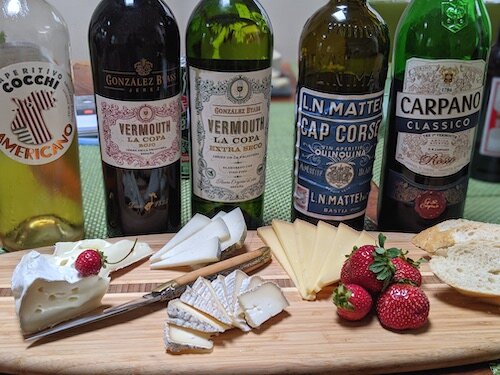A Closer Look at Vermouth & Cheese Pairing
Serving wine and cheese before dinner is an oh-so-American tradition that befuddles the more European palate. Cheese can be quite filling, especially piled high in all-American fashion, and wine can overpower the pre-dinner palate, and often bulldoze the cheese as well.
Luckily there’s vermouth, the aromatized wine—full of flavors of herbs, bark, roots—bitter, sweet, citrusy botanicals that perk up the flagging appetite.
Vermouth is an aperitif (from the Latin word for “open”) made bitter with botanical infusions, made sweet and boozy with the introduction of brandy or other neutral spirits to up the alcohol a notch over table wine level.
Vermouths vary widely by style, from the “dry” white familiar from Martinis and cooking to the less dry bianco/blanc style, to the “sweet” reds that are well known for mixing in Manhattans. They come from France (Dolin is a great one, or try the classic Noilly Prat), Italy (also known as Torino-style, named for Italy’s historic vermouth hub, like Carpano, Starlino, and Contratto), Spain (La Pivón, Axa, Yzaguirre—we also tried some tasty La Copa vermouths made from sherry), or the good old USA (Lo-fi, Uncouth, Vya, Oso de Oro). Even Japan has entered the burgeoning vermouth race with Oka Kura Bermutto made from sake!
Professional and home bartenders are embracing the vermouth-as-aperitif trend. “There was a time during my career as a bartender where I thought vermouth was only mean for cocktails – sweet for Manhattans and dry for Martinis,” says Fatima Butler, Bartender and Founder/CEO of Rooted in Hospitality. “I was so wrong. Their herbal flavors make them so perfect on their own. They’re great with a twist of lemon and also work on ice with soda.”
Butler also noted the increasing popularity of vermouth in the US. According to a report from Vine Pair, interest in vermouth has continued to rise in the wine category.
Interest in vermouth courtesy of VP Pro
Recently, we conducted a (very fun) tasting of a wide range of vermouths with an array of cheese styles. On the beverage side, we also included wine-based aperitifs in our cheese tasting session. Why? Because their citrus-y, earthy, herbal aromatics are just so darn fun with cheese., and they align with the vermouth family so closely. Our findings did not yield precise pairings, as much as informal recommendations.
Vermouths and cheese
Vermouth & Cheese Pairings
We loved Lillet, perhaps the queen of all aperitifs, made in Bordeaux from the wine of the region, plus oranges, sugar, and lots of secret ingredients, as a partner to a rich, creamy fresh chèvre.
La Pivon Rojo Vermouth from Madrid showed herbal and floral, with a big rose petal aroma, and worked very nicely with grassy Gruyere. We suspect Manchego and other aged cheeses would also do nicely with this beverage.
We matched a soft-ripened sheep from Siena, Italy with Cap Corse, a Corsican quinquina with balanced bitterness, minerality, and citrus notes, and the cheese’s earthy richness did quite well. A bandaged British style cheddar was also a hit, likely due to its cave-influenced flavors.
A mild and munchy American aged goat cheese got very friendly with the gentle bittersweet balance of Cocchi Americano, the aromatized wine from Asti in Northern Italy whose aromatic base of Moscato di Asti is bittered with cinchona bark.
We added a sharp, salty, artichoke-y Spanish raw sheep cheese to test out its herbal flavors with our lineup. The classic cola flavors of Carpano Antico Rosso and the Starlino Rosso both gently complimented this rather challenging pairing.
A sweet, well-aged, crystalline Dutch gouda played well with the spiced sherried and candied fruit notes of a Gonzalez Byass Vermouth La Copa, made from a blend of Oloroso and Pedro Ximenez sherries and bittered with wormwood, herbs, and quinine.
Overall, we highly recommend an exploration of the bitter, fruity, saline, and herbal characters of the aperitif wine world matched with the creamy, nutty, grassy, and lactic flavors found in cheese. These non-traditional partnerships will make a fun evening of aromatic adventure for your next gathering. Start with your local vermouth, perhaps or a bottle of aperitif from your favorite region of Europe, build a cheese board (plus some charcuterie never hurts) and enjoy.



